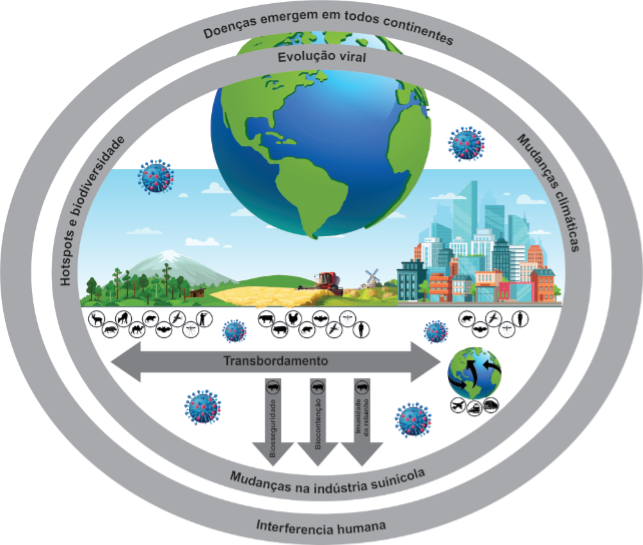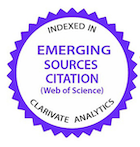One health approach for the surveillance of novel swine viral diseases
DOI:
https://doi.org/10.1590/1809-6891v24e-74048PAbstract
The novel coronavirus pandemic highlighted the importance of discussing and monitoring emerging diseases to scientific society, particularly in the case of zoonotic diseases. Diseases emerge in nature and infect living beings current on all continents, even in the current scenario of biomedical research evolution. Among the most studied emerging animal diseases are the swine viral diseases, due to their high occurrence and severity. Added to this, is the economic impact on the health of pigs and in some cases on human health. The challenges of swine health include endemic diseases, foodborne and transboundary diseases. Idiopathic vesicular diseases and subclinical diseases have also been identified, either alone or in combination with other infections. Several factors have contributed to these phenomena, but failures in biosecurity, biocontainment, and herd immunity imbalances are critical and must be addressed. Viruses evolve naturally, through mutation, rearrangement, or recombination, either to become more virulent or more transmissible, or not. This review will discuss the broad field of emerging swine viral infections, how monitoring the evolution of these viral agents is of supreme importance. Also, when should a new disease or emerging agent is considered a risk to swine production? Although the evolution of pork production systems is admirable, animal diseases continue to account for 20% of the losses. Therefore, international organizations work with member countries to prevent animal diseases, ensure food supply, maintain household income, health, and preserve the future. One Health is not just a concept, but an action of surveillance and control that all countries must implement.
Keywords: Emergence; Evolution; Pig Disease; Public Health
Downloads
References
Zanella JRC, Morés N, Barcellos DESNd. Main endemic health threats in the swine production chain in Brazil. Pesqui Agropecu Bras. 2016;51(5):443-53.
Chen Q, Li G, Stasko J, Thomas JT, Stensland WR, Pillatzki AE, et al. Isolation and characterization of porcine epidemic diarrhea viruses associated with the 2013 disease outbreak among swine in the United States. 2014;52(1):234-43.
Ramirez-Medina E, O’Donnell V, Silva E, Espinoza N, Velazquez-Salinas L, Moran K, et al. Experimental Infection of Domestic Pigs with an African Swine Fever Virus Field Strain Isolated in 2021 from the Dominican Republic. 2022;14(5):1090.
Arzt J, White WR, Thomsen BV, Brown CC. Agricultural diseases on the move early in the third millennium. Vet Pathol. 2010;47(1):15-27.
Linhares D. PEDv, Etiologia, impacto na produção e modos de transmissão. Simposio Brasil Sul de Suinocultura2014.
Drew TJRSeT-O. The emergence and evolution of swine viral diseases: to what extent have husbandry systems and global trade contributed to their distribution and diversity? 2011;30(1):95.
VanderWaal K, Deen JJPotNAoS. Global trends in infectious diseases of swine. 2018;115(45):11495-500.
Mishra J, Mishra P, Arora NKJES. Linkages between environmental issues and zoonotic diseases: with reference to COVID-19 pandemic. 2021;4(3):455-67.
Cutler SJ, Fooks AR, van der Poel WH. Public health threat of new, reemerging, and neglected zoonoses in the industrialized world. Emerg Infect Dis. 2010;16(1):1-7.
Yadav MP, Singh RK, Malik YS. Emerging and transboundary animal viral diseases: Perspectives and preparedness. Emerging and Transboundary Animal Viruses: Springer; 2020. p. 1-25.
Bekedam H. Emerging Infectious Diseases, Defending against Infectious Diseases & Biological Threats. APEC2006.
Zanella JRCJPAB. Emerging and reemerging zoonoses and their importance for animal health and production. 2016;51(5):510-9.
Ellwanger JH, Chies JABJBJoID. Zoonotic spillover and emerging viral diseases–time to intensify zoonoses surveillance in Brazil. 2018;22:76-8.
Kelly TR, Machalaba C, Karesh WB, Crook PZ, Gilardi K, Nziza J, et al. Implementing One Health approaches to confront emerging and re-emerging zoonotic disease threats: lessons from PREDICT. 2020;2(1):1-7.
Perfumo CJ, Pereda A, Jongkaewwattana A, Chen Z, Perez DR, Ma JJFiVS. Emerging swine viruses. 2020;7:132.
Davies PRJT, diseases e. One world, one health: the threat of emerging swine diseases. A North American perspective. 2012;59:18-26.
Shi M, Lin X-D, Chen X, Tian J-H, Chen L-J, Li K, et al. The evolutionary history of vertebrate RNA viruses. 2018;556(7700):197-202.
An T-Q, Li J-N, Su C-M, Yoo DJVr. Molecular and cellular mechanisms for PRRSV pathogenesis and host response to infection. 2020;286:197980.
Al Farroukh M, Kiseleva I, Bazhenova E, Stepanova E, Puchkova L, Rudenko LJV. Understanding the Variability of Certain Biological Properties of H1N1pdm09 Influenza Viruses. 2022;10(3):395.
Jung K, Saif LJ, Wang QJVr. Porcine epidemic diarrhea virus (PEDV): An update on etiology, transmission, pathogenesis, and prevention and control. 2020;286:198045.
COHEN J. A coronavirus variant once helped the global pork industry. Could one protect us? 2022 [Available from: https://www.science.org/content/article/coronavirus-variant-once-helped-global-pork-industry-could-one-protect-us.
Fielding BC. How viruses evolve. 2020.
MUNKEVICS M. How do viruses evolve and why it happens so quickly 2020 [Available from: https://www.monkeygene.com/how-viruses-evolve/?gclid.
Cui J, Li F, Shi Z-LJNRM. Origin and evolution of pathogenic coronaviruses. 2019;17(3):181-92.
Kapoor A, Kumar A, Simmonds P, Bhuva N, Singh Chauhan L, Lee B, et al. Virome analysis of transfusion recipients reveals a novel human virus that shares genomic features with hepaciviruses and pegiviruses. 2015;6(5):e01466-15.
Cuestas MLJRAdM. New virus discovered in blood supply: Human Hepegivirus-1 (HHpgV-1). 2016;48(2):180-1.
CDC. SARS-CoV-2 Variant Classifications and Definitions 2022 [Available from: https://www.cdc.gov/coronavirus/2019-ncov/variants/variant-classifications.html.
Sahoo JP, Pradhan P, Nath S, Samal KCJBRT. Newly Found NeoCov COVID Variant from Bats Possibly Deadlier than Previous Strain. 2022;4(2):085-7.
Plowright RK, Parrish CR, McCallum H, Hudson PJ, Ko AI, Graham AL, et al. Pathways to zoonotic spillover. 2017;15(8):502-10.
Nelson MI, Vincent ALJTim. Reverse zoonosis of influenza to swine: new perspectives on the human–animal interface. 2015;23(3):142-53.
John Deen D. Prevention and control of emerging and re-emerging zoonotic swine diseases. [Available from: chrome-extension://efaidnbmnnnibpcajpcglclefindmkaj/https://www.cabi.org/ISC/FullTextPDF/2014/20143082275.pdf

Published
How to Cite
Issue
Section
License
Copyright (c) 2022 Brazilian Animal Science/ Ciência Animal Brasileira

This work is licensed under a Creative Commons Attribution 4.0 International License.
Authors who publish with this journal agree to the following terms:
- Authors retain copyright and grant the journal right of first publication with the work simultaneously licensed under a Creative Commons Attribution License that allows others to share the work with an acknowledgement of the work's authorship and initial publication in this journal.
- Authors are able to enter into separate, additional contractual arrangements for the non-exclusive distribution of the journal's published version of the work (e.g., post it to an institutional repository or publish it in a book), with an acknowledgement of its initial publication in this journal.
- Authors are permitted and encouraged to post their work online (e.g. in institutional repositories or on their website) prior to and during the submission process, as it can lead to productive exchanges, as well as earlier and greater citation of published work (See The Effect of Open Access).































